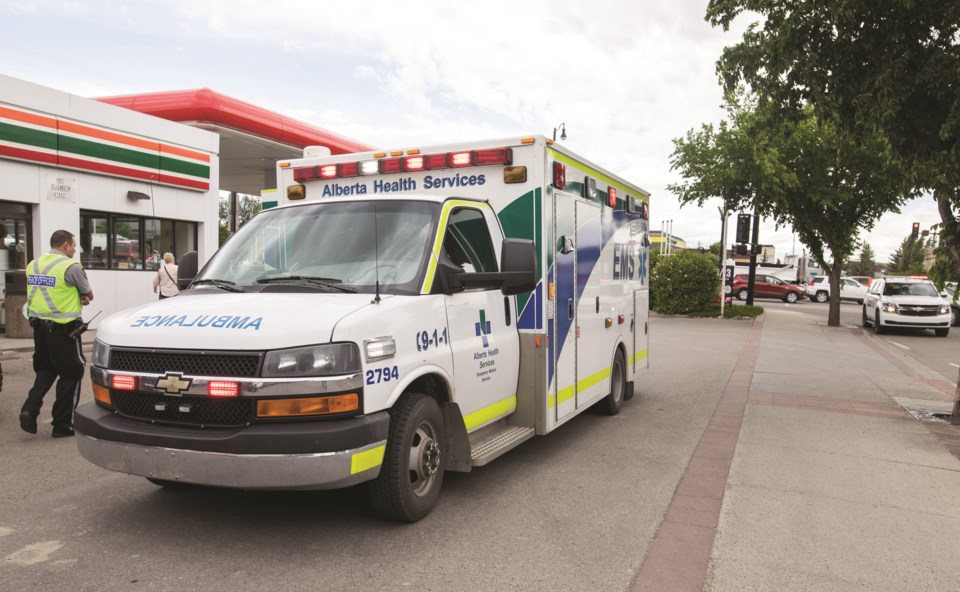There could be options for keeping ambulances in the Foothills area if the government follows a recommendation on its health-care review.
The Ernst & Young report on Alberta Health Services (AHS) listed non-emergent patient transportation as one of the current areas where cost savings could be found. By moving non-critical transport of patients to other vehicles, rather than EMS ambulances, fewer medically-trained staff would be necessary and ambulances could be more readily available outside of Calgary.
Suzanne Oel, chair of Foothills Regional Emergency Services Commission, said the group is “cautiously optimistic” about the Ernst & Young recommendation, as a lack of ambulances in the region is often an issue.
“It’s a large area served by a few ambulances,” said Oel. “We feel that pressure right away when something is used for purposes other than intended.”
She said using high-level service vehicles for essentially taxi-like patient transfers is taking up resources rather than leaving units on standby in the communities they’re intended to serve.
“The units are getting caught up in the city and also then being called as the closest ambulance while they’re still in the city, and then also personnel getting stuck in the halls of hospitals,” said Oel. “There’s a domino effect that happens when the whole unit gets flexed to other communities, leaving that station area without coverage.”
It’s particularly troublesome when the reason ambulances are called out of the community is to provide non-emergency transfers, she said.
When a unit is called out of its station area, another vehicle is flexed, meaning it’s called to the border of its community or coverage area, so that it’s possible to cover more than one area. This often results in code-reds, with long ambulance wait-times, she said.
“With all of this happening, there is a reduction in service levels,” said Oel. “There’s an increase in ambulance response times, there’s reduced availability of the high-level ambulances, the advanced life support.”
She said that results in an overall cost to taxpayers, who are paying for high-level resources when lower-level services could be used instead.
There is also an added burden to municipalities, which foot the bill for fire medical responses when ambulances are not available to respond, she said.
“There are a number of medical calls when fire is first-on-scene due to ambulances being far away or units being caught up on non-emergent services,” said Oel. “These are costs municipalities are bearing, because municipalities are invested in providing high-level service to their residents.”
She said while the report does look at possible solutions, such as third-party contracted services for non-emergent transport, the solutions generally focus on urban centres – namely Calgary, Edmonton and Red Deer.
For rural areas, the suggestion is to look at mixed-used of ambulances and non-ambulance transport units where feasible – and that’s cause for some concern, she said.
“We’d like to have this scope expanded on that, and to include solutions for the rural and suburban rural in the areas that aren’t listed as the cities,” said Oel.
If proper standards were put in place, it should be possible to have a variety of compliant non-ambulance transport units throughout the province, she said.
However, if the Province allows AHS to initiate a turf protection policy, allowing only one contractor to provide transportation services, it could exclude a lot of rural areas.
She cited a transport service that was shut down because limitations had been placed on its operation.
“AHS determined these particular non-emergent units could only respond on the Highway 2 corridor, so they cut off the ability for this unit to be able to expand use into another jurisdiction,” said Oel.
She said FRESC would rather see consideration given to a few accredited contractors who could provide service and are not limited to jurisdictional boundaries, to make it more financially viable and efficient.
“This is really the crux of it – can we get realistic about how this solution could come into being, especially for the areas where it looks like the report hasn’t really put a lot of thought into it,” said Oel.
Streamlining transportation services could have significant benefits for the Foothills area, as well as other rural regions, by allowing ambulance units to stay on standby in their own communities, she said.
There could be cost savings, quicker response times, and fewer code-red situations when the area is lacking coverage, she said.
Despite some flaws in the report’s suggestions, Oel said FRESC is willing to back the recommendation to find alternate solutions for patient transport.
“We’re in cautious agreement, because the rurals get dismissed,” said Oel. “Sometimes the definition of the greater good is population, and we struggle with that all the time in our role of supporting rural Alberta.
“That’s just a constant job for us, to defend that there is value to serving our residents.”
Krista Conrad, OkotoksToday.ca




